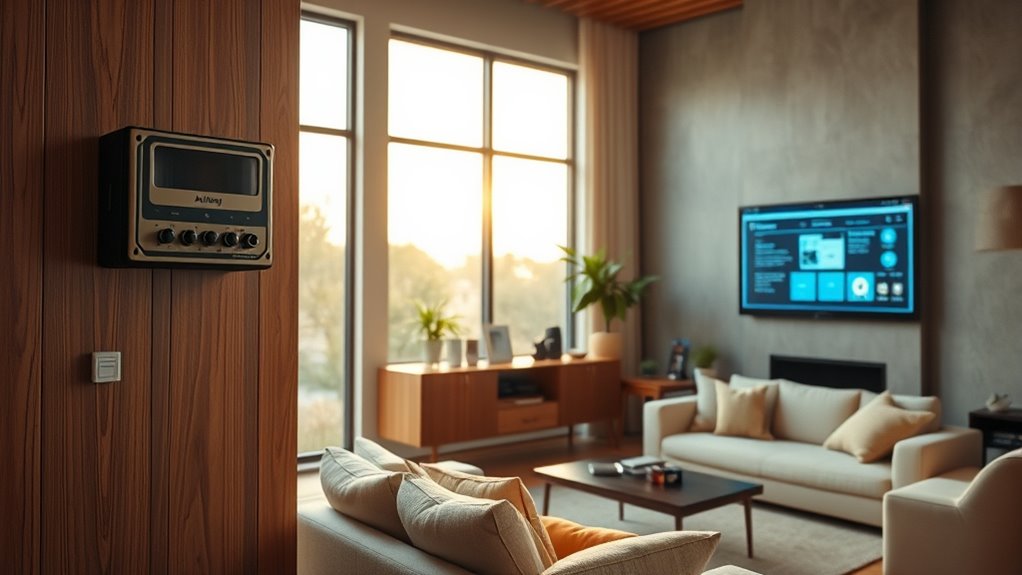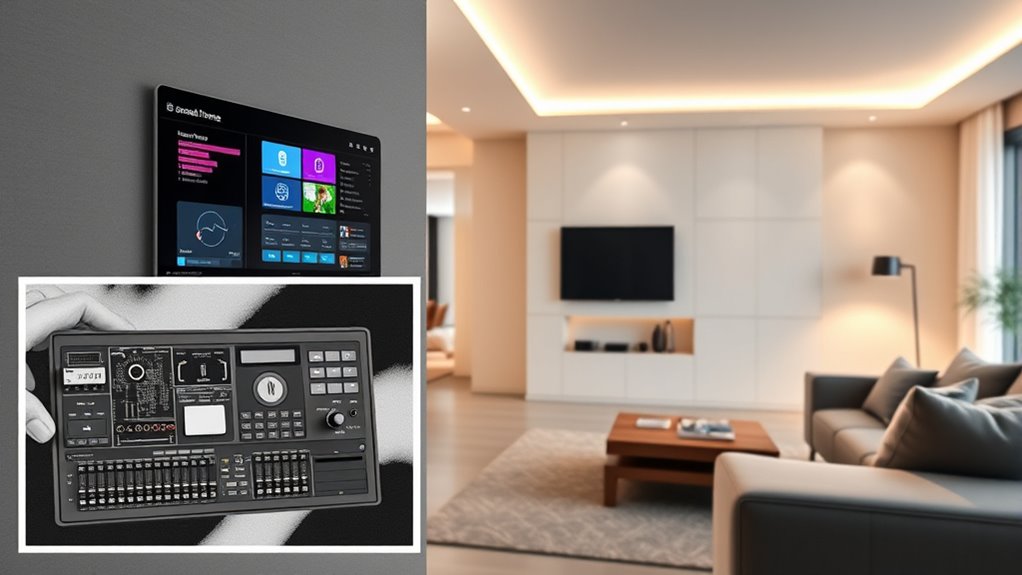Since 1963, smart home technology has advanced from basic fault alert systems requiring manual action to sophisticated wireless networks like KNX that enable seamless device integration. Modern systems allow you to automatically monitor, control, and optimize everything from security to energy use via smartphone or voice commands. Wireless technologies like Zigbee or Z-Wave foster reliable, scalable environments that support real-time diagnostics and upgrades. If you continue exploring, you’ll discover how these innovations shape smarter, more efficient homes today.
Key Takeaways
- Fault reporting systems originated in 1963 with basic alerts, evolving to real-time proactive notifications via wireless technologies.
- Wireless technologies like Wi-Fi, Zigbee, and Z-Wave enable seamless device communication and remote control in smart homes.
- Modern systems monitor and optimize energy consumption, reducing waste and utility costs through automation.
- Standards such as KNX ensure interoperability, simplifying integration and expansion of diverse smart home devices.
- Advances in wireless tech have made smart home ecosystems more scalable, reliable, and user-friendly over time.

Smart homes have rapidly evolved from simple automation systems to integrated environments that enhance convenience, security, and energy efficiency. Today, you can control almost every aspect of your home with a tap or voice command, thanks to advancements in wireless technologies. These innovations have transformed how devices communicate, enabling seamless connectivity and smarter management of your living space. Wireless technologies like Wi-Fi, Zigbee, Z-Wave, and Bluetooth have become the backbone of modern smart homes, allowing devices to interact without the clutter of wires. This wireless infrastructure simplifies installation, expands compatibility, and creates a flexible ecosystem where you can add or upgrade gadgets easily.
One of the key areas where these wireless technologies make a significant impact is energy management. Smart systems now monitor and optimize energy consumption in real time, helping you reduce waste and lower utility bills. For example, smart thermostats learn your schedule and preferences, adjusting the temperature automatically to maximize comfort and efficiency. Similarly, smart lighting systems can be controlled remotely and programmed to turn off when not needed, further conserving energy. These features not only make your home more eco-friendly but also give you more control over your energy use, making your living environment more sustainable.
The evolution from early fault reporting systems in 1963 to today’s integrated smart homes reflects continuous innovation. Back then, fault reporting was limited to basic alerts, often requiring manual intervention. Now, with the advent of wireless technologies, your home can proactively detect issues like leaks, electrical faults, or system failures and notify you instantly via your smartphone. This proactive approach minimizes damage, improves safety, and reduces maintenance costs. The integration of these wireless systems also enables remote troubleshooting and diagnostics, so you don’t need to be physically present to resolve problems.
Over time, standards like KNX have emerged, bringing greater interoperability and control. KNX acts as a universal language for smart home devices, ensuring that different brands and systems can work together seamlessly. This standardization enhances the reliability of your smart home setup and simplifies expansion or upgrades. Whether you’re adding new sensors, security cameras, or energy management tools, KNX makes integration straightforward. Moreover, wireless communication technologies have further advanced the capabilities of these systems, allowing for more robust and scalable networks.
In essence, the evolution of smart homes is driven by wireless technologies that foster energy management, security, and convenience. You benefit from smarter, more connected environments that adapt to your lifestyle, save energy, and keep you safer. From basic fault reporting to complex, integrated systems, the journey reflects a continuous pursuit of smarter living, where technology becomes an invisible yet indispensable partner in your daily life.
Frequently Asked Questions
How Do Smart Home Devices Communicate Securely?
You guarantee smart home devices communicate securely by using strong encryption protocols, which protect data during transmission. Additionally, device authentication verifies that only authorized devices connect to your network, preventing unauthorized access. Keep your firmware updated and use secure Wi-Fi passwords to enhance security. By combining these measures, you maintain a safe environment where your smart devices operate seamlessly without risking your personal information.
What Are the Future Trends in Smart Home Technology?
Future trends in smart home technology include seamless voice control and advanced AI integration, making your home more intuitive and responsive. You’ll see smarter devices that learn your habits, anticipate needs, and automate routines effortlessly. Enhanced security, personalized experiences, and energy efficiency will become standard. As AI evolves, your home will become more connected, adaptive, and easier to manage, transforming the way you live and interact with your environment.
How Affordable Are Advanced Smart Home Systems?
Imagine a world where home automation feels like an open door rather than a locked vault. Advanced smart home systems are becoming more affordable, making device affordability accessible for many. You can now enjoy seamless integration without breaking the bank, as technology progresses and prices drop. This shift means you’re more empowered than ever to upgrade your home, turning everyday living into a smarter, more convenient experience without the hefty price tag.
Can Smart Homes Be Integrated With Renewable Energy Sources?
Yes, smart homes can be integrated with renewable energy sources through renewable integration and energy management systems. You can connect solar panels or wind turbines to your smart home setup, allowing automated energy optimization. These systems monitor your renewable sources, adjust consumption, and store excess energy efficiently. By doing so, you reduce reliance on the grid, lower costs, and promote sustainability, making your home more eco-friendly and energy-efficient.
What Are the Privacy Risks Associated With Smart Home Devices?
Imagine your home’s lights flickering, not from a power surge, but from unseen eyes watching every move. You face privacy risks like data breaches and invasive user profiling with smart devices. Your personal habits, routines, and preferences become data points vulnerable to hacking or misuse. It’s essential to secure your devices, use strong passwords, and stay informed to protect your privacy and keep your home safe from prying eyes.
Conclusion
You’ve seen how smart homes have evolved from simple fault reporting in 1963 to the sophisticated, interconnected systems of today like KNX. As technology continues to advance, imagine what your future home could do—anticipate your needs, enhance your comfort, and simplify your life. Are you ready to embrace this smart revolution and transform the way you live? The journey from basic automation to seamless integration is just beginning, and it’s an exciting world waiting for you.








